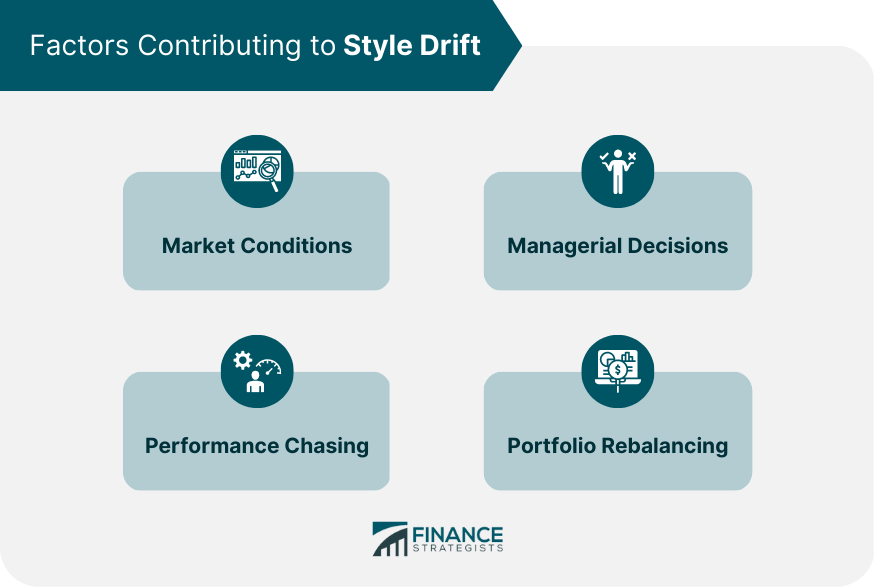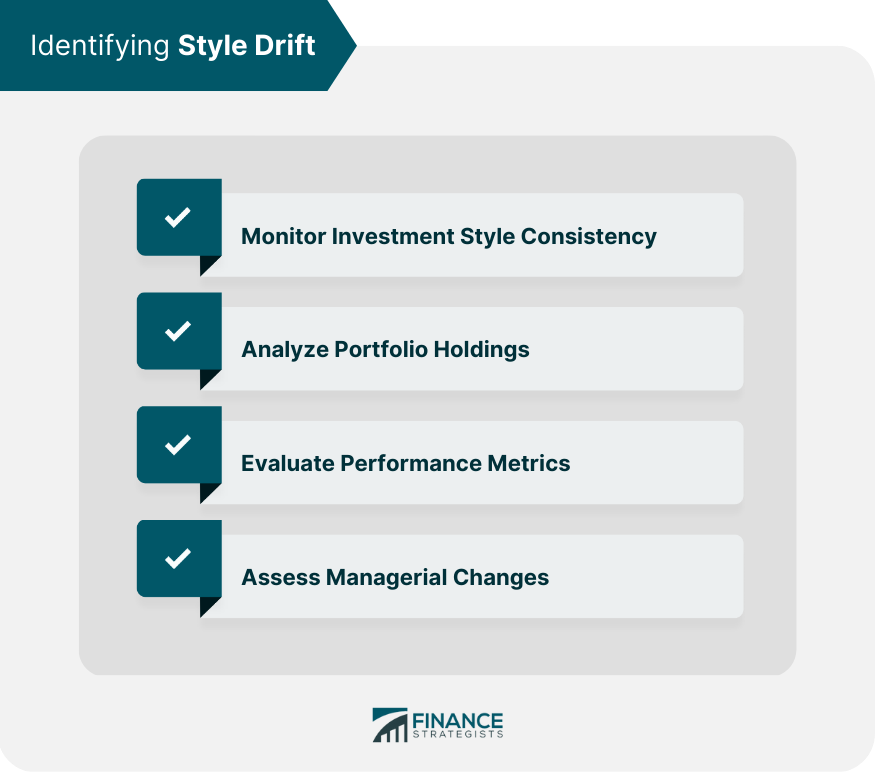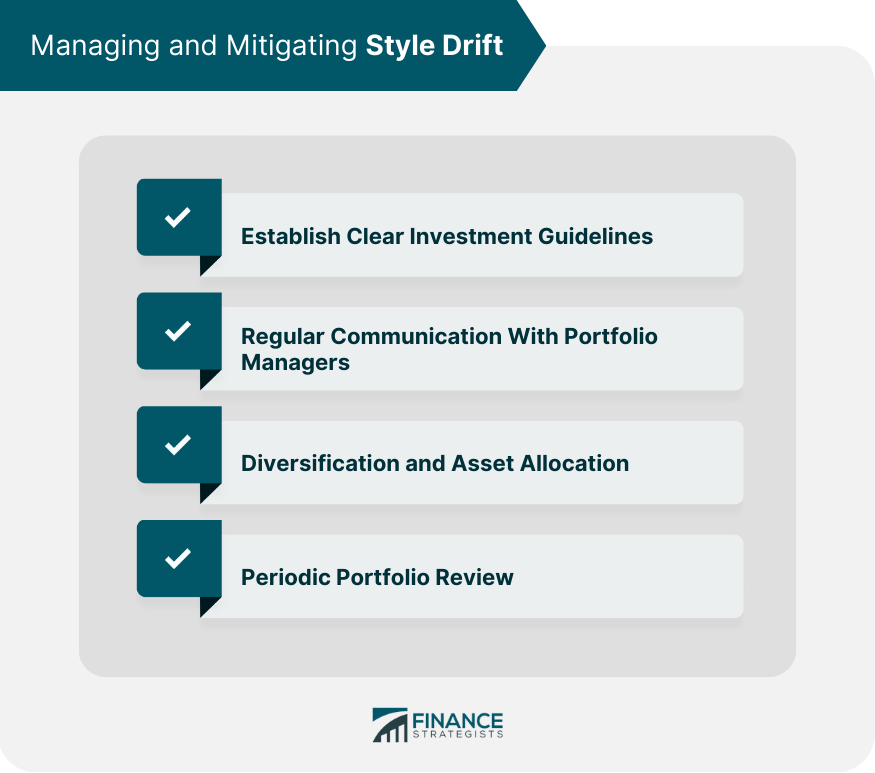Style drift occurs when an investment manager deviates from their stated investment style or strategy, resulting in a change in the risk and return characteristics of the investment portfolio. This can lead to discrepancies between an investor's expectations and their investments' actual performance and behavior. Style drift can be caused by various factors, including market conditions, managerial decisions, performance chasing, and portfolio rebalancing. It may be intentional or unintentional and can result from both active and passive management decisions. Style drift can have significant implications for investors, as it can lead to changes in their investments' risk and return profile. This can result in portfolios that are not aligned with investors' objectives, risk tolerance, and investment time horizon, potentially leading to suboptimal investment outcomes. Several factors can contribute to style drift in investment management. Market conditions can play a role in style drift, as investment managers may adjust their investment strategies in response to changing market dynamics. This can lead to deviations from the stated investment style, as managers seek to adapt to new opportunities or challenges in the market. Managerial decisions can also contribute to style drift, as investment managers may intentionally or unintentionally deviate from their stated investment style in pursuit of higher returns or reduced risk. This can result from changes in the investment manager's philosophy, approach, or objectives. Performance chasing occurs when investment managers alter their investment strategies to pursue short-term gains or replicate the performance of top-performing investments. This can lead to style drift, as managers shift their focus away from their stated investment style in an effort to capture short-term gains. Portfolio rebalancing can also contribute to style drift, as investment managers adjust their portfolio holdings to maintain desired risk and return characteristics. This may result in deviations from the stated investment style, particularly if the rebalancing process is not carefully managed or aligned with the investment manager's objectives. Detecting style drift is essential for investors to ensure their portfolios remain aligned with their investment objectives and risk tolerance. Investors should monitor the consistency of their investment manager's style to detect any signs of style drift. This can be achieved by regularly reviewing the manager's investment philosophy, process, and objectives to ensure they remain aligned with the stated investment style. Analyzing the holdings within an investment portfolio can help investors identify style drift, as deviations from the stated investment style may be reflected in the composition of the portfolio. By regularly reviewing portfolio holdings, investors can detect shifts in investment focus that may indicate style drift. Performance metrics can be useful in identifying style drift, as changes in the risk and return characteristics of a portfolio may be indicative of deviations from the stated investment style. By comparing the portfolio's performance against relevant benchmarks and peers, investors can assess whether any discrepancies may be attributable to style drift. Managerial changes, such as the departure or arrival of investment managers, can also contribute to style drift. Investors should closely monitor any changes in the investment management team, as these changes may signal shifts in investment philosophy or strategy that could lead to style drift. Effectively managing and mitigating style drift is essential for ensuring that investment portfolios remain aligned with investors' objectives and risk tolerance. This section will discuss the importance of establishing clear investment guidelines, maintaining regular communication with portfolio managers, diversifying and allocating assets, and conducting periodic portfolio reviews. Investors can help prevent style drift by establishing clear investment guidelines that outline the acceptable range of deviation from the stated investment style. These guidelines should be communicated to the investment manager and reviewed regularly to ensure ongoing alignment with the investor's objectives. Maintaining regular communication with portfolio managers is crucial for managing style drift. By discussing investment decisions, performance, and any potential changes in strategy, investors can stay informed about the manager's approach and more effectively identify and address any instances of style drift. Diversification and asset allocation can help mitigate the impact of style drift on investment portfolios. By spreading investments across a range of asset classes and investment styles, investors can reduce the potential impact of any single investment manager's style drift on the overall portfolio performance. Conducting periodic portfolio reviews is essential for detecting and addressing style drift. These reviews should involve a comprehensive assessment of the portfolio's holdings, performance, and risk characteristics to ensure ongoing alignment with the investor's objectives and risk tolerance. Style drift is a phenomenon where an investment manager deviates from their stated investment style. This can present both benefits and risks for investors. In some cases, style drift may lead to enhanced investment performance, as the manager adapts their strategy to capitalize on new opportunities or navigate changing market conditions. However, investors must carefully weigh this potential benefit against the potential risks associated with deviating from the stated investment style. Style drift can expose investors to unintended risks, as the manager's actions may result in a portfolio that is not aligned with the investor's risk tolerance or objectives. This misalignment can lead to suboptimal investment outcomes and increased portfolio volatility. Style drift can also impact portfolio diversification, as the manager's deviation from the stated investment style may result in an overly concentrated or imbalanced portfolio. This lack of diversification can increase the portfolio's risk and potentially diminish its long-term performance. Style drift can make it challenging for investors to accurately assess an investment manager's skill and performance. By deviating from their stated investment style, a manager may make it difficult to determine whether their performance is attributable to skill or to style drift. Investors should be aware of this risk when evaluating investment managers. Monitoring style drift is essential for ensuring that investment portfolios remain aligned with investors' objectives and risk tolerance. By understanding the causes of style drift and implementing strategies to manage and mitigate its impact, investors can more effectively achieve their long-term investment goals. While style drift can present challenges, it is essential to strike a balance between flexibility and consistency in investment management. By allowing for some degree of adaptation to changing market conditions, investors can potentially benefit from enhanced performance without compromising their investment objectives. Investor diligence is crucial in managing style drift. For investors seeking assistance in managing style drift and optimizing their investment portfolios, professional wealth management services can provide valuable guidance and expertise.What Is Style Drift?
Factors Contributing to Style Drift

Market Conditions
Managerial Decisions
Performance Chasing
Portfolio Rebalancing
Identifying Style Drift

Monitoring Investment Style Consistency
Analyzing Portfolio Holdings
Evaluating Performance Metrics
Assessing Managerial Changes
Managing and Mitigating Style Drift

Establishing Clear Investment Guidelines
Regular Communication with Portfolio Managers
Diversification and Asset Allocation
Periodic Portfolio Review
Benefits and Risks of Style Drift
Benefits
Potential for Enhanced Performance
Risks
Unintended Risk Exposure
Impact on Portfolio Diversification
Manager Accountability and Skill Assessment
Final Thoughts
Style Drift FAQs
Style drift refers to when an investment manager deviates from their stated investment style or strategy, resulting in a change in the risk and return characteristics of the investment portfolio.
Style drift can be caused by various factors, including market conditions, managerial decisions, performance chasing, and portfolio rebalancing. It may be intentional or unintentional and can result from both active and passive management decisions.
Style drift can expose investors to unintended risks, as the manager's actions may result in a portfolio that is not aligned with the investor's risk tolerance or objectives. This misalignment can lead to suboptimal investment outcomes and increased portfolio volatility.
Investors can monitor the consistency of their investment manager's style, analyze portfolio holdings, evaluate performance metrics, and assess managerial changes to identify style drift. To manage style drift, investors can establish clear investment guidelines, maintain regular communication with portfolio managers, diversify and allocate assets, and conduct periodic portfolio reviews.
Investor diligence is crucial in managing style drift. By actively monitoring investment managers, establishing clear investment guidelines, and conducting periodic portfolio reviews, investors can more effectively detect and address instances of style drift, ensuring their portfolios remain aligned with their objectives and risk tolerance.
True Tamplin is a published author, public speaker, CEO of UpDigital, and founder of Finance Strategists.
True is a Certified Educator in Personal Finance (CEPF®), author of The Handy Financial Ratios Guide, a member of the Society for Advancing Business Editing and Writing, contributes to his financial education site, Finance Strategists, and has spoken to various financial communities such as the CFA Institute, as well as university students like his Alma mater, Biola University, where he received a bachelor of science in business and data analytics.
To learn more about True, visit his personal website or view his author profiles on Amazon, Nasdaq and Forbes.











